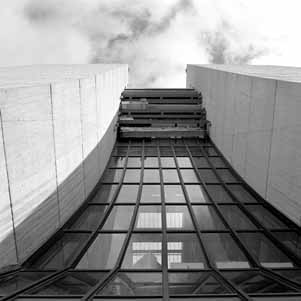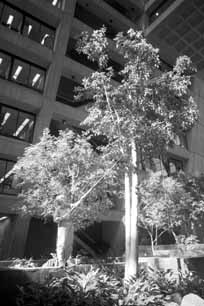 |
|
Wilson Hall Upgrades Let the Sun Shine in by Chad Boutin
Trees and shrubs fill the entryway; ivy climbs the lower cross floors. But until recently, little sun had reached them, because the skylights were less windows than walls.
"The original designers had to add a layer of plastic under the skylights, in case they broke," said Elaine McCluskey, project manager for the Wilson Hall Safety Improvement Program. "Unfortunately, it was an imperfect fit, and there was no way to maintain them, so water and dirt would get in between. You couldnít see out."
Now new skylight panes have let the sunshine in for an even greener future. The atrium plants are seeing more light from above, and Sue Grumboski, who cares for the foliage, has already seen the difference.
Wilson Hall is entering the home stretch of its lengthy rehabilitation, a project that has altered the building in ways both subtle and profound. None of the changes will be dramatic enough to raise eyebrows at first glance. But the quality of life in the atrium will improve for everyone and everything inside, as the plants have already found.
Perhaps the most noticeable outward change has been in the building glass between the highrise towers. Gone are the plate-glass panes that once covered the north facade above the main entrance; in their place are sheets of safety glass with plastic cores, much like the glass in a car windshield.
"The old glass would shatter into sharp pieces," McCluskey said. "But if it breaks now, the plastic will hold it together, or it will break into round pieces that will be less likely to hurt you. The safety glass is also made in smaller pieces than the old panes, and thatís why the windows are divided into three sections now."
The atrium space has always created a congenial atmosphere among Fermilab scientists. Lunchroom napkins are the scratch pads of physics history; researchers routinely scrawl ideas for new experiments on them for their hamburger-munching colleagues. But Illinois weather has taken its toll on the highrise, and in 1993, a fist-sized chunk of concrete fell through a sloped window pane, shattering the glass and the sense of calm within. The fertile buzz of conversation stopped.
Congress eventually allocated over $15 million to strengthen the concrete and make other improvements to the building.
If you look up from the atrium nowadays, you still see some scaffolding, but most of the work on the internal concrete is finished. Once the work is completed, McCluskeyís crew will begin replacing the windows on the southern facade, aiming to finish by late summer.
The last improvement to the atrium atmosphere will be to the air itself. The main entrance is closed for now, but when it reopens in July, revolving doors will keep more of the air conditioning inside, and keep Illinois weather out.
It will take a few more months before the highrise emerges from the last of its construction, but when it does, it will be ready again for more good buzz. And more sunshine.
On the Web: |
| last modified 3/16/2001 by C. Hebert email Fermilab |
FRLsDFx9eyfrPXgV
 What would the Wilson Hall atrium be without its greenery?
What would the Wilson Hall atrium be without its greenery?
 "On the south facing plants I have noticed more bright green color, more vibrant growth," she said. "Now that I have light, I am getting growth on the back sides of trees. I only used to get growth on the north side. And the spathiphyllum, the `Q-tip tree' on the south end, is blooming for the first time. We have flowers blooming that never did before we cleaned the skylights."
"On the south facing plants I have noticed more bright green color, more vibrant growth," she said. "Now that I have light, I am getting growth on the back sides of trees. I only used to get growth on the north side. And the spathiphyllum, the `Q-tip tree' on the south end, is blooming for the first time. We have flowers blooming that never did before we cleaned the skylights."